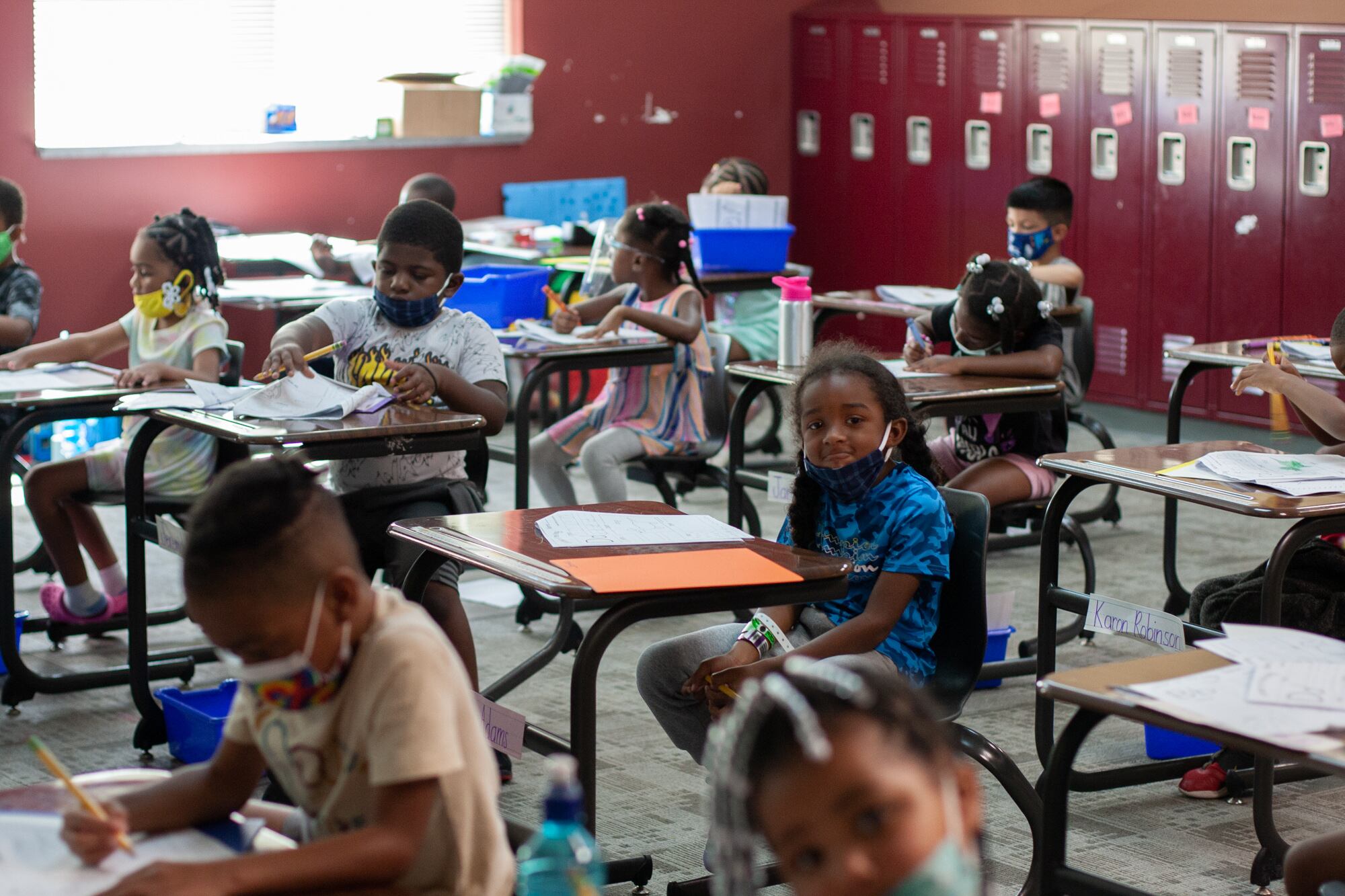Like many school districts, Indianapolis Public Schools saw a steep enrollment drop among its youngest students last year.
School started off remote, and many families opted not to have their young children learn online. The kindergarten class shrank to 2,430 students from 2,750 students the year before, while the preschool class was barely half its previous size.
A lot has changed since then. School is in person again, and the district’s overall enrollment is up. At 2,670 students, the kindergarten class is closer to what it was before the pandemic, and the preschool class has just a few open slots.
“We believe that we’re rebounding and that families are choosing to come back,” Superintendent Aleesia Johnson told school board members in late October.
After last year’s historic enrollment disruptions, when kindergarten enrollment fell 9% nationwide, school districts across the U.S. are reporting an uptick in their early grades as more students return to in-person learning.
Though the numbers often remain below pre-pandemic levels, the trajectory has many school leaders breathing a small sigh of relief — and could indicate some schools’ efforts to recruit and re-engage with families who left for private school or to homeschool paid off.
But the pandemic’s imprint on enrollment is still obvious, and officials nationwide say they aren’t yet confident about the longer-term trends.
Some, like Indianapolis Public Schools, didn’t see first grade enrollment declines this year, likely because children arrived after skipping kindergarten. But other elementary grades there are still smaller than they were before the pandemic began.
Patrick Herrel, the district’s enrollment director, isn’t sure if that’s a “temporary bubble” or something more. In the meantime, the district is taking a conservative approach to its enrollment projections.
“We’re going to continue to have to be really thoughtful as a district, because we do continue to wrestle with long-term financial sustainability,” he said. “It’s a challenge.”
Kindergarten enrollment is up elsewhere, too. In Miami-Dade County schools, the number of kindergartners fell from 22,800 to 20,900 last fall, but rose to around 21,600 this year. Broward County, Florida’s kindergarten class shrank from around 18,500 to 16,300 last fall, and rebounded to 17,100 this year.
In Georgia, the kindergarten class dropped from around 126,000 to 114,000 last fall, and shot up to 122,000 this year. Hawaii’s kindergarten class fell from 13,100 to 11,100 last year, and rose a bit to 11,500 this fall.
And in Arizona, where the kindergarten class was growing pre-pandemic, the number of kindergartners fell to 73,000 from just under 82,000 last fall. This year, preliminary counts have state officials estimating somewhere between 75,000 and 80,000 kindergartners.
Still, many big-city districts that were shrinking pre-pandemic saw overall enrollment drops again after experiencing especially large declines last fall.
Enrollment in New York City fell 1.9% after dropping 4.7% last year. Chicago’s student body decreased by 3% after declining 4% last fall. Miami-Dade County’s schools lost 1.5% of their enrollment, after experiencing a 3.7% drop last year, district data show. Broward County, Florida’s enrollment dipped 1.8% this fall, after dropping 2.7% last year, according to a district report.
Los Angeles schools, meanwhile, saw a larger-than-expected drop and lost 6% of their students this fall, after seeing a 4% decline last year. District officials now say they will hire more enrollment staff to work on attracting and retaining students.
“We’re still seeing the impact of COVID,” the district’s chief strategy officer, Veronica Arreguin, said, the Los Angeles Times reported. “If it’s something we can change, we need to change.”
Parents and school officials attribute the kindergarten rebounds to a combination of factors, including the return of full-time in-person instruction, waning COVID safety concerns, and vaccine availability. Kindergarten enrollment was especially depressed by virtual learning last year, researchers have found.
Jenny Rappaport’s 6-year-old son, Milo, was so upset by virtual kindergarten last year that he often hid under his desk or retreated behind blankets to avoid class. Milo has apraxia, which affects his motor and speech skills, and he found it frustrating when his teacher couldn’t understand him over Zoom. In the spring, Rappaport and her husband unenrolled Milo from his public school in Monmouth County, New Jersey and homeschooled him instead.
This fall, the family re-enrolled Milo for first grade. Milo’s teacher is better able to observe how he deciphers words as he reads in person. He’s getting speech services twice a week and he raves about his art and music classes, which were limited over Zoom. And he’s more social, bonding with a classmate over a shared love of Super Mario.
“It’s a substantially better experience,” Rappaport said. “It’s a huge relief.”
In the small southwest Michigan district of Coloma Community Schools, officials are trying to understand their spike in new kindergartners. Typically the district’s kindergarten class numbers 80 to 90 students, but this year it’s at 112, prompting the district to hire an additional teacher.
That’s “almost never happened,” said Superintendent Dave Ehlers. Now Ehlers is poring over survey data. “We do know that some of the kids told us: ‘Hey we sat out last year,’” he said.
Some districts that were growing before the pandemic are still feeling a bit knocked off course. That’s the case in suburban Detroit’s Woodhaven-Brownstown Schools, where the kindergarten class dipped last fall from 480 to around 390, and is back at 450 this year.
Officials aren’t sure how much to blame the pandemic. A drop in births meant a decline in 5-year-olds was expected around this time, but COVID also disrupted kindergarten recruitment tactics. District leaders swapped their usual enrollment fairs at local apartment complexes this summer for school buses that drove through neighborhoods with banners.
“Will we be returning to a more normalized class size, or will this be something that becomes a normal and a standard in our school district?” Superintendent Mark Greathead said. “It’s a little too soon to know.”
What enrollment declines will mean for schools over the next few years remains to be seen. In general, enrollment matters to schools because losing students can mean losing funds, which could translate into less staff and bare-bones academic programming.
But when a state loses students, education costs go down, too. If a state is in a strong financial position, officials could decide to hold education budgets steady and spend more on the students who remain — or to make other choices.
Those decisions will affect whether schools eventually feel a squeeze as their headcounts decline, and school districts where enrollment is dropping the fastest will be in the toughest position. Another worry for schools: Having fewer students enrolled could also weaken political support for public school spending.
For now, districts are focusing on getting the students they have up to speed.
In Clayton County, Georgia, Superintendent Morcease Beasley was heartened to see kindergarten numbers rise after last year’s drop to around 3,000 from 3,500 the previous fall. The class numbers almost 3,400 this year, state data shows. Now, Beasley said, the task ahead is to build reading skills among the district’s youngest students and to help older students fill in gaps.
“Last year we were virtually learning, and while we did our best, we do know that students were not necessarily learning as much,” Beasley said. “We’ve got work to do.”
Matt Barnum contributed reporting.





